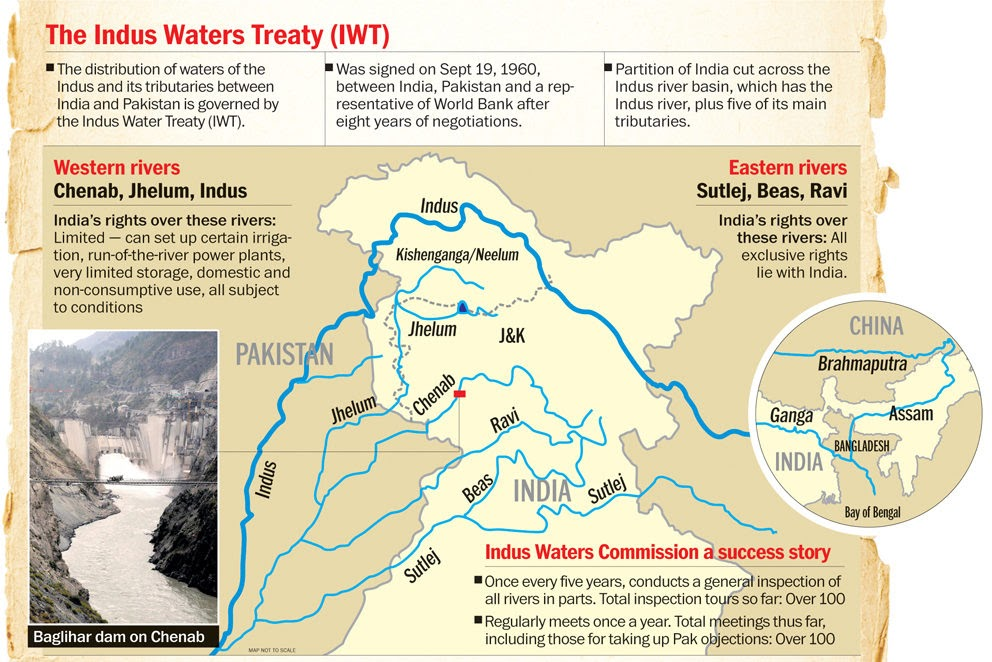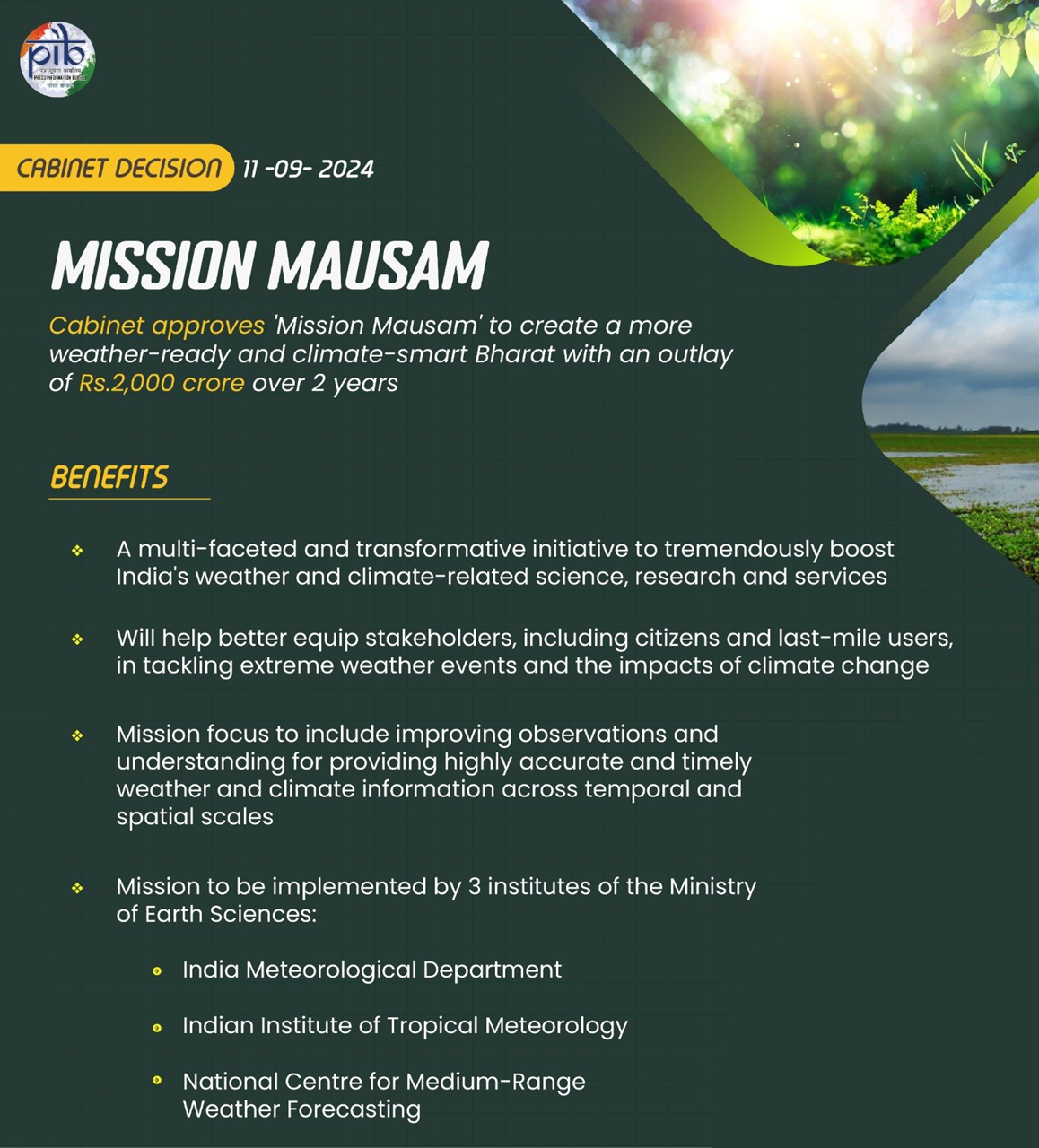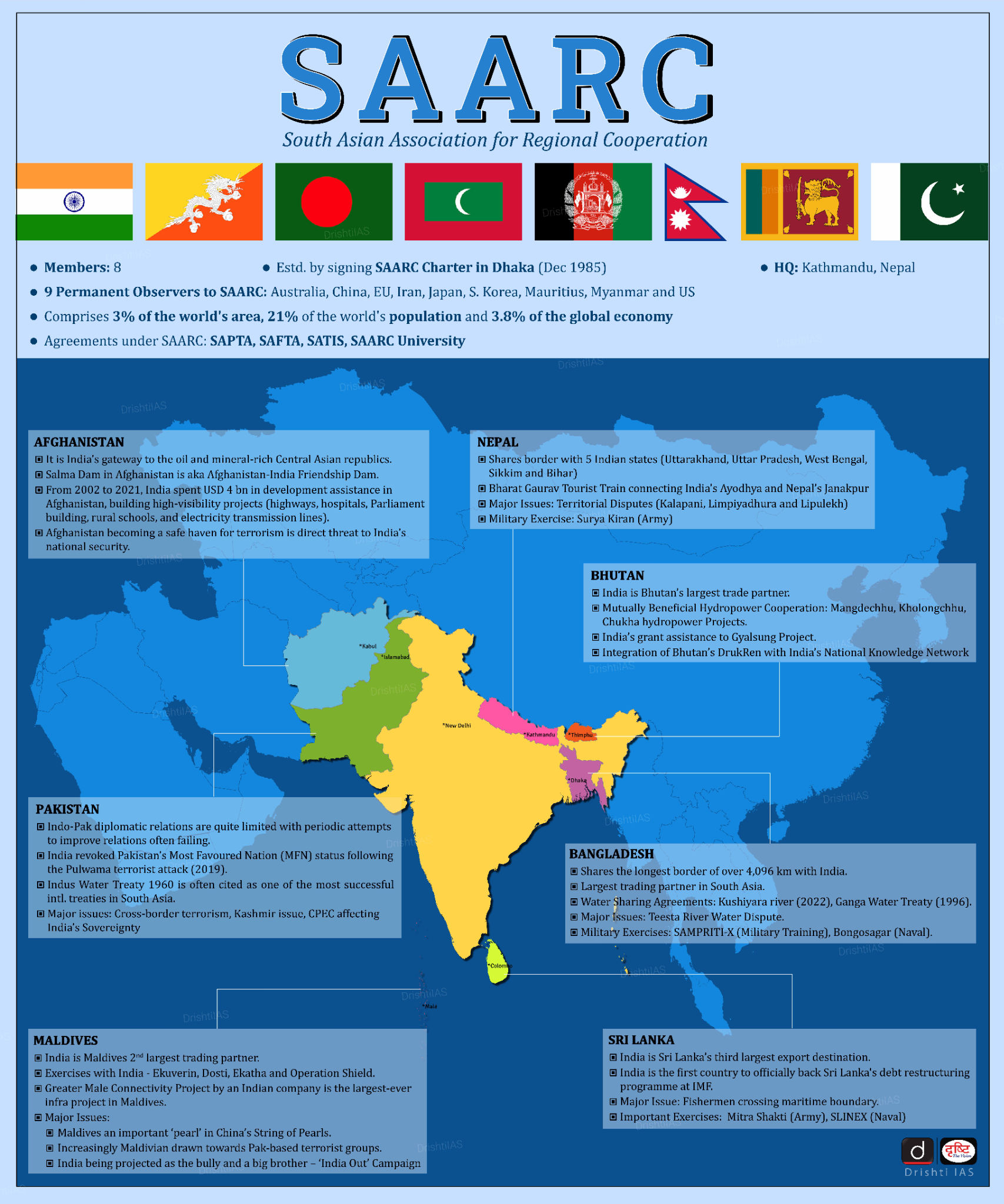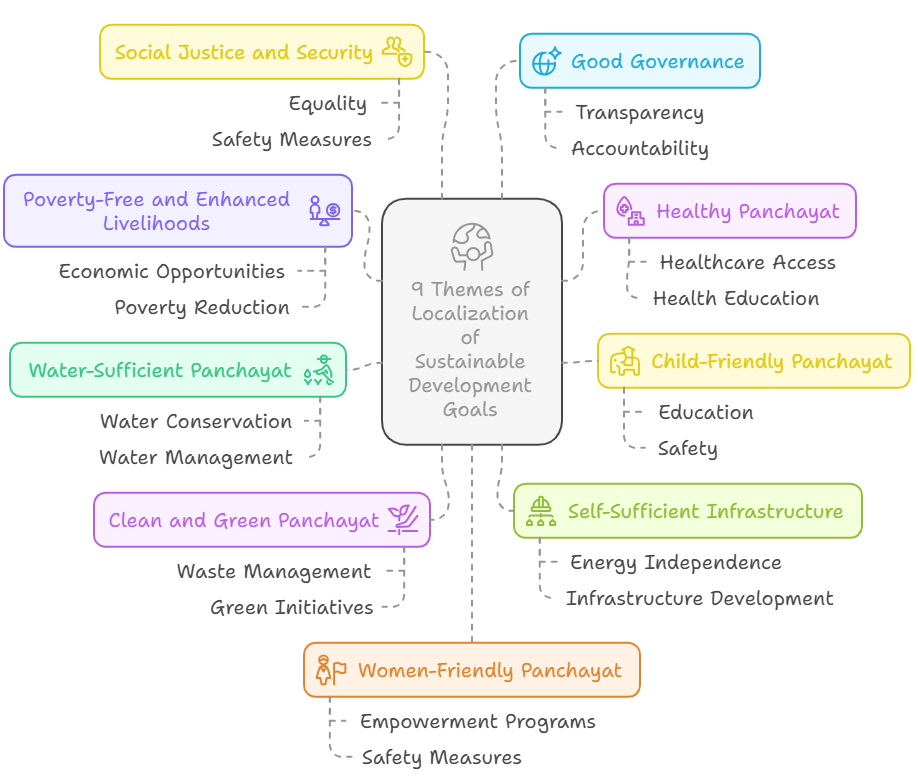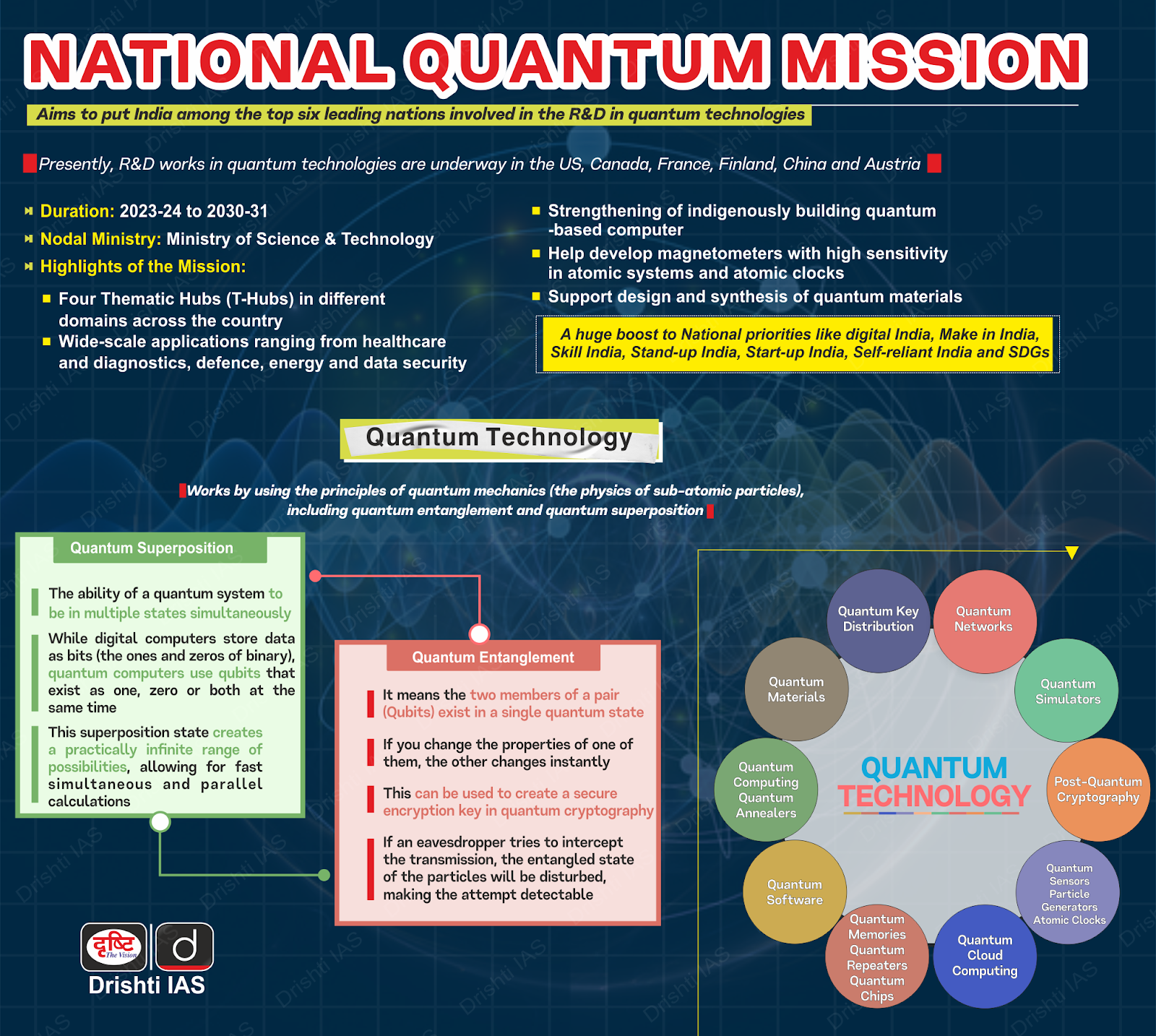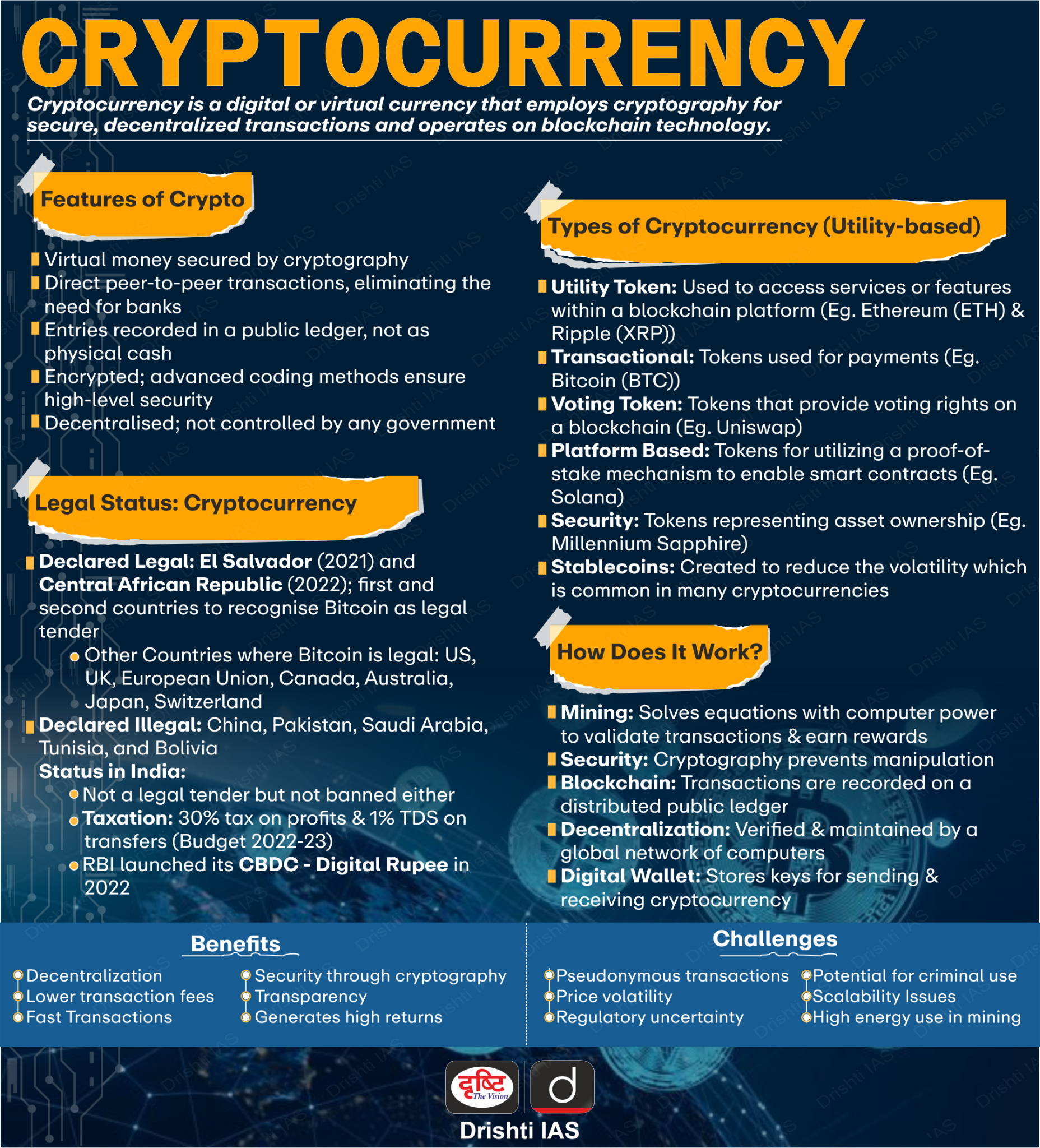International Relations
Pahalgam Terror Attack and Suspension of the Indus Waters Treaty
For Prelims: The Resistance Front, Indus Waters Treaty, Integrated Check Post, Article 370, World Bank, Permanent Court of Arbitration
For Mains: Suspension of the Indus Waters Treaty, Terrorism and Security, India’s Foreign Policy and Strategic Interests
Why in News?
The Cabinet Committee on Security, chaired by Prime Minister Narendra Modi, has approved a 5-point action plan against Pakistan following the deadly terrorist attack in Baisaran valley (Pahalgam), Jammu and Kashmir, which claimed the lives of 26 civilians.
- The Resistance Front (TRF), a proxy of banned Pakistan-based Lashkar-e-Taiba (LeT), reportedly claimed responsibility for the attack.
Note: The TRF surfaced in 2020. It was declared a terrorist organisation by the Ministry of Home Affairs in 2023 under the Unlawful Activities (Prevention) Act, 1967 for its involvement in terror recruitment, infiltration, and smuggling from Pakistan into J&K.
- TRF's rise followed two key developments: the decapitation of LeT's top leadership in 2018 and the revocation of J&K’s special status in 2019.
What is the 5-Point Action Plan Announced by India After the Pahalgam Terror Attack?
- Suspension of the Indus Waters Treaty: India has suspended the 1960 Indus Waters Treaty (IWT) until Pakistan ceases its support for cross-border terrorism.
- It reflects a shift in India’s strategic calculus, using hydrological leverage as a pressure tool.
- Closure of the Attari-Wagah Border Check Post: India has shut down the Integrated Check Post (ICP) at Attari, Punjab suspending all movement of people and goods.
- Only individuals who have crossed over with valid documents will be permitted to return by 1st May 2025.
- Cancellation of SAARC Visa Exemption Scheme for Pakistan: India has revoked the South Asian Association for Regional Cooperation (SAARC) Visa Exemption Scheme (SVES) for Pakistani nationals.
- All SVES visas already issued are considered void.
- Expulsion of Pakistani Military Advisors: Pakistan’s Defence, Naval, and Air advisors in New Delhi have been declared persona non grata and must exit India. India will also withdraw its own advisors from Islamabad.
- Reduction of Diplomatic Personnel: India will reduce the staff strength at its High Commission in Islamabad to 30, down from 55, by 1st May 2025.
- This marks a clear downgrade in diplomatic engagement, intended to freeze bilateral dialogue at the official level.
What are the Potential Geopolitical Factors Behind Pakistan's Pahalgam Attack?
- India’s Kashmir Policy: Pakistan views India's revocation of Article 370 in 2019 and Kashmir's integration as a challenge to its self-claimed sovereignty due to its illegal occupation over Pakistan-occupied Kashmir.
- Pakistan's increasing marginalization and India's success in stabilizing Kashmir may have pushed Pakistan to resort to violence to reassert its position in the region.
- International Isolation: Pakistan’s traditional allies like the US, Gulf states, and even China are distancing themselves due to Islamabad’s declining reliability and returns.
- Additionally, the US withdrawal from Afghanistan in 2021, Pakistan's strategic importance to the US has sharply declined, leaving it diplomatically isolated.
- Economic Collapse: A crumbling economy, soaring inflation, and weak state institutions have left Pakistan increasingly unstable.
- Rising Baloch insurgency and persistent terror activities along Pakistan’s western front have made the country less appealing to foreign investors, worsening its economic troubles and hindering prospects for recovery.
- Global Geopolitical Messaging: The timing of the Pahalgam attack, coinciding with PM Modi’s visit to Saudi Arabia and the US Vice President’s trip to India, suggests Pakistan is asserting its regional power and signaling its continued influence in South Asia.
- Despite global condemnation, Pakistan may see international attention as an opportunity to re-engage diplomatically amid its growing isolation.
What is the Significance of the Indus Waters Treaty?
- Indus Waters Treaty: The IWT, signed in 1960 in Karachi after nine years of negotiations between India and Pakistan, was mediated by the World Bank.
- The treaty allocates the "Eastern Rivers" of the Indus system (Ravi, Beas, and Sutlej) to India for unrestricted use, while the "Western Rivers" (Indus, Jhelum, and Chenab) are reserved for Pakistan, effectively giving Pakistan access to about 80% of the total water.
- India is allowed limited non-consumptive uses of the Western Rivers, such as for navigation, agriculture, and hydroelectricity, subject to design and operational conditions under the treaty.
- IWT established a Permanent Indus Commission (PIC) to ensure annual dialogue and cooperation, and laid out a three-tier dispute resolution mechanism, including resolution at the PIC level, through a Neutral Expert (appointed by the World Bank or jointly by the India and Pakistan), or if needed, a Court of Arbitration.
- The treaty allocates the "Eastern Rivers" of the Indus system (Ravi, Beas, and Sutlej) to India for unrestricted use, while the "Western Rivers" (Indus, Jhelum, and Chenab) are reserved for Pakistan, effectively giving Pakistan access to about 80% of the total water.
- Actions Regarding IWT: In 2023, India issued its first notice under the IWT, requesting modifications to the Treaty, focusing on the Kishenganga and Ratle hydroelectric projects.
- Despite these projects being classified as "run-of-the-river" and intended to generate electricity without obstructing the natural river flow, Pakistan raised concerns, claiming they violate the IWT’s stipulations.
- India responded with another notice in 2024, seeking a review and modification of the IWT.
- Article XII (3) of the IWT allows for modifications to the Treaty through a duly ratified agreement between the two governments.
- India’s Suspension of the IWT: India’s suspension marks the first suspension of the treaty since its inception, signaling a shift in water diplomacy linked to cross-border terrorism.
- Article 62 of the Vienna Convention allows a country to withdraw from or repudiate a treaty if there is a fundamental change in circumstances that makes the continuation of the treaty untenable.
- Implications of IWT Suspension:
- India: Suspension of the IWT gives India greater flexibility in managing the Indus river system.
- India can now carry out reservoir flushing on projects like Kishanganga (Jhelum) without waiting for the peak monsoon period, as previously mandated by the treaty. This will help in increasing the life of the Kishenganga dam.
- India can fast-track hydroelectric projects on western rivers, bypassing design and operational restrictions, and halt Pakistani inspections at ongoing projects like Kishenganga and Ratle (on Chenab).
- However, the suspension won’t immediately affect Pakistan’s water supply, as India lacks the infrastructure to fully control or divert the flow at this stage.
- Pakistan: The suspension of the IWT threatens Pakistan's water security, as 80% of its cultivated land relies on these rivers.
- Disruption could impact food security, urban water supply, and power generation, while also causing economic instability due to the Indus system's contribution to 25% of Pakistan's GDP.
- India's ability to withhold river flow data further compounds Pakistan's vulnerability, hindering flood preparedness and water resource management.
- Pakistan may pursue arbitration, seek World Bank aid, and rally allies like China to negotiate favorable terms with India, but economic constraints may limit strong retaliation.
- India: Suspension of the IWT gives India greater flexibility in managing the Indus river system.
Note: Reservoir flushing is a technique used to remove accumulated sediment from reservoirs by releasing water through low-level outlets to scour out the sediment and transport it downstream.
India’s Key Dams on the Indus System
- Kishanganga (Jhelum): Operational since 2018, diverts water from a key tributary of the Mangla Dam.
- Ratle (Chenab): Under construction, may further reduce flows to Pakistan's Punjab region.
- Shahpurkandi (Ravi): Redirects Ravi water to Indian channels, reducing Pakistan's access.
- Ujh (Ravi): A planned dam that will decrease downstream water availability to Pakistan.
What Should Be India’s Long-Term Strategy Toward Pakistan?
- Strengthening Deterrence: India must maintain a strong military presence along the border, modernizing its forces with High Tech Border Surveillance System, and smart fencing.
- A credible deterrent, including robust border security, can prevent Pakistan from escalating tensions, particularly over Kashmir or potential military incursions
- Utilizing UN Security Council: India should persist in highlighting Pakistan’s support for terrorist groups at the UN Security Council, emphasizing global condemnation.
- India should leverage Article 51 of the UN Charter, which calls for collective action against terrorism, to mobilize global support for greater sanctions on Pakistan.
- Additionally, India should advocate for Pakistan’s inclusion in the Financial Action Task Force (FATF) blacklist for its involvement in terror financing, to pressure Pakistan into compliance.
- Internal Resilience and Social Cohesion: India must adopt a proactive counter-radicalization strategy, focusing on vulnerable border regions.
- This involves not just security measures, but also fostering unity through public awareness campaigns that emphasize peace, pluralism, and national cohesion.
|
Drishti Mains Question: Analyze the implications of the suspension of the Indus Waters Treaty by India. How does this impact India’s strategic interests and Pakistan? |
UPSC Civil Services Examination, Previous Year Question (PYQ)
Prelims:
Q. With reference to the Indus river system, of the following four rivers, three of them pour into one of them which joins the Indus directly. Among the following, which one is such a river that joins the Indus direct? (2021)
(a) Chenab
(b) Jhelum
(c) Ravi
(d) Sutle
Ans: (d)
Q. Consider the following pairs (2019)
|
Glacier |
River |
|
1. Bandarpunch |
Yamuna |
|
2. Bara Shigri |
Chenab |
|
3. Milam |
Mandakini |
|
4. Siachen |
Nubra |
|
5. Zemu |
Manas |
Which of the pairs given above are correctly matched?
(a) 1, 2 and 4
(b) 1, 3 and 4
(c) 2 and 5
(d) 3 and 5
Ans: (a)
Mains:
Q. The interlinking of rivers can provide viable solutions to the multi-dimensional inter-related problems of droughts, floods, and interrupted navigation. Critically examine. (2020)
Q. The scourge of terrorism is a grave challenge to national security. What solutions do you suggest to curb this growing menace? What are the major sources of terrorist funding? (2017)


Science & Technology
AI Driven Weather Forecasting
For Prelims: Artificial Intelligence, Machine Learning, World Meteorological Organization, El Nino, Indian Ocean Dipole
For Mains: Role of AI/ML in climate and weather forecasting in India, Importance of Mission Mausam for climate resilience
Why in News?
The growing incidence of extreme events, such as heatwaves and flash floods, is pushing India to increasingly rely on Artificial Intelligence (AI) and Machine Learning (ML) to enhance its weather forecasting capabilities, a move further bolstered by the launch of ‘Mission Mausam’
How is India Adopting AI-Based Weather Forecasting?
- AI-Based Weather Forecasting: It refers to the use of AI and Machine Learning to analyze data from various sources to predict weather patterns and extreme events with high accuracy, helping in better decision-making and disaster management.
- India's Key Initiatives Related to AI Based Forecasting:
- Weather Information Network and Data System (WINDS): The Ministry of Agriculture and Farmers Welfare has initiated the WINDS to generate hyper-local, long-term weather data.
- WINDS will install over 200,000 ground stations, significantly enhancing weather data collection, which will improve weather predictions, especially for agricultural and disaster management needs.
- AI and Machine Learning Centre: The MoES has established an AI and Machine Learning Centre in Pune to enhance weather forecasts, focusing on short-range rainfall predictions, high-resolution urban datasets, and nowcasting rainfall and snow using Doppler radar data.
- AI-based Monsoon Prediction Models: DST Centre of Excellence in Climate Modelling (CECM) at IIT-Delhi in collaboration with other researchers have developed AI/ML-based models for monsoon prediction, using historical data and climate drivers like El Nino and the Indian Ocean Dipole (IOD).
- These models have demonstrated better performance than traditional physical models, with a forecast success rate of 61.9% for the 2002-2022 period.
- The models can also predict rainfall months in advance and can be updated based on evolving climate data.
- Weather Information Network and Data System (WINDS): The Ministry of Agriculture and Farmers Welfare has initiated the WINDS to generate hyper-local, long-term weather data.
What is Mission Mausam?
- About: Mission Mausam, launched in 2024 under the Ministry of Earth Sciences (MoES), to modernize India's weather and climate forecasting systems.
- It aims to make the country “Weather Ready” and “Climate Smart” by enhancing scientific research, disaster preparedness, and sector-specific advisories.
- Need: India’s dependence on agriculture, increasing climate variability, and frequent extreme weather events make accurate forecasting vital.
- Mission Mausam addresses these challenges by enhancing monsoon prediction for better crop planning and supporting rural development through improved resource management and infrastructure planning.
- Implementation Strategy: It will be implemented mainly by the India Meteorological Department (IMD), Indian Institute of Tropical Meteorology(IITM), and the National Centre for Medium-Range Weather Forecasting (NCMRWF).
- It focuses on enhancing weather forecasting through infrastructure development (Doppler radars, weather stations).
- The mission also leverages supercomputing power, utilizing advanced systems like Pratyush and Mihir for precise climate modeling.
- Current Status: Over 37 Doppler Weather Radars are installed across India, enhancing real-time monitoring.
- The Mausam app offers weather forecasts for 450 cities, and seasonal prediction models have improved under the National Monsoon Mission.
How is AI Forecasting Different from Traditional Forecasting Methods?
|
Aspect |
AI Models |
Traditional Methods (Numerical Weather Prediction (NWP)) |
|
Data-Driven vs. Physics-Based |
AI models use large datasets to detect patterns and correlations without understanding physical processes, such as atmospheric interactions, uncovering hidden connections. |
Traditional models use physical equations on fluid dynamics and thermodynamics to simulate the atmosphere. |
|
Computational Approach |
AI enhances real-time forecasting by evolving algorithms and detecting subtle patterns. |
NWP models need supercomputers for complex, time-consuming calculations, especially in long-term forecasts. |
|
Flexibility and Adaptability |
AI adapts to new data, handles diverse inputs (e.g., ocean salinity), and adjusts to different geographical conditions. |
NWP models rely on fixed rules, making them less flexible and requiring updates for extreme events. |
|
Prediction of Extreme Events |
AI predicts extreme events like heatwaves and floods more accurately and earlier by analyzing large datasets. |
NWP is good for general weather but struggles with localized extreme events. |
What are the Challenges with AI-based Forecasting?
- Data Quality and Availability: AI models need large, high-quality datasets, but weather data is often inconsistent, sparse, or inaccurate, especially in remote areas.
- Complex Weather Systems: Weather systems are chaotic and nonlinear, making it difficult for AI to predict them accurately. Regional variability adds further complexity.
- Interpretability: AI models often act as “black boxes,” meaning their predictions are hard to explain, leading to trust issues among non-experts.
- Lack of Expertise: AI-based forecasting requires cross-disciplinary expertise in both climate science and machine learning, which is scarce in India.
- Limited Computational Infrastructure: AI models require significant computing power, especially for high-resolution forecasts.
- Many Indian institutions still lack the necessary infrastructure, such as high-performance GPUs, to support AI-based weather prediction.
- Bias and Trust Issues: AI models are often criticized for their "black-box" nature, making it difficult to interpret how predictions are made.
- AI models may inherit biases from the data they’re trained on, leading to unreliable predictions, and public trust in AI-based forecasts is a concern.
What Measures Can Improve the Effectiveness of AI-Based Weather Forecasting in India?
- Hybrid Approach: Combining AI/ML with traditional physics-based models creates hybrid systems that leverage the strengths of both.
- This approach enhances forecast accuracy, especially for complex weather patterns, by fusing data-driven insights with physical atmospheric principles.
- Crowdsourcing for Localized Data Collection: Leveraging platforms like Google Maps, and Google DeepMind's GenCast AI model, citizens can contribute localized weather data, aiding real-time feedback for AI models to refine predictions.
- Integrating this data into apps like Mausam enhances community-driven forecasting, improving accuracy for extreme weather events.
- Expanding Ground Station Networks: Expanding Automatic Weather Stations (AWS) and Automatic Rain Gauges (ARG) networks through initiatives like WINDS (which aims to create 200,000+ new stations) will strengthen data for AI models.
- Tapping into private sector networks and ensuring seamless integration can further boost forecasting accuracy.
- Global Collaboration: India can accelerate AI-based weather forecasting by collaborating with global leaders like Google, and National Aeronautics and Space Administration (NASA) on joint projects and shared datasets.
- Establishing AI/ML and Climate Science Institutes will foster interdisciplinary expertise, supported by the DST and MoES.
- Hosting annual AI in Weather Forecasting Conferences and offering training programs will ensure a continuous supply of skilled professionals.
|
Drishti Mains Question: What are the major challenges faced in implementing Artificial Intelligence based weather forecasting in India? Suggest measures to overcome them. |
UPSC Civil Services Examination, Previous Year Question (PYQ)
Prelims
Q. With reference to ‘Indian Ocean Dipole (IOD)’ sometimes mentioned in the news while forecasting Indian monsoon, which of the following statements is/are correct? (2017)
- IOD phenomenon is characterised by a difference in sea surface temperature between tropical Western Indian Ocean and tropical Eastern Pacific Ocean.
- An IOD phenomenon can influence an El Nino’s impact on the monsoon.
Select the correct answer using the code given below:
(a) 1 only
(b) 2 only
(c) Both 1 and 2
(d) Neither 1 nor 2
Ans: (b)
Mains:
Q. What do you understand by the phenomenon of temperature inversion in meteorology? How does it affect weather and the inhabitants of the place? (2013)


Important Facts For Prelims
SAARC Visa Exemption Scheme
Why in News?
The Cabinet Committee on Security (CCS) has revoked the South Asian Association for Regional Cooperation (SAARC) Visa Exemption Scheme (SVES) for Pakistani nationals following the Pahalgam terror attack.
- This marks a firm diplomatic response to Pakistan’s continued support for cross-border terrorism.
What is the SAARC Visa Exemption Scheme?
- SVES: Launched in 1992, based on the decision of the 4th SAARC Summit in 1988 held in Islamabad. It is designed to facilitate people-to-people contact and regional cooperation among SAARC nations.
- Purpose: It permits select individuals from member countries to travel without a visa using a Special Travel Document.
- It covers 24 categories, including dignitaries, judges, parliamentarians, officials, businesspersons, journalists, and sportspersons.
- Validity: Visa Stickers are issued by each SAARC member state to eligible individuals from their country, typically valid for one year and reviewed regularly by immigration authorities.
- India Specific Provisions: Citizens of Nepal and Bhutan do not need a visa to enter India. For Pakistani nationals, only select categories were eligible for a multiple-entry Business Visa—initially valid for one year and limited to 10 locations.
- In 2015, India revised the rules, allowing special-category Pakistani businessmen a multiple-entry visa valid for up to three years, restricted to 15 designated places.
- Among SAARC countries, Sri Lankan nationals were eligible for the e-Tourist Visa facility.
- Indian nationals do not need a visa to visit Nepal and Bhutan, while other SAARC countries offer Business Visa facilities to Indian citizens.
- India’s Revocation of SVES for Pakistan: The CCS notified that all SAARC Visa Exemption Scheme (SVES) visas issued to Pakistani nationals are now void, and those currently in India under this scheme must leave the country
Note: India signed an agreement with Pakistan in 2019, outlining the modalities for operationalizing the Shri Kartarpur Sahib Corridor, which allowed visa-free pilgrimage for Indian Sikhs to Gurdwara Darbar Sahib in Pakistan.
Cabinet Committee on Security (CCS)
- CCS headed by the Prime Minister, it includes ministers from Finance, Defence, Home Affairs, and External Affairs. Other members may include defence chiefs and senior bureaucrats.
- It plays a pivotal role in India’s national security framework, dealing with critical matters related to defense, law and order, and foreign affairs.
- CCS was first convened during the Indo-Pak War of 1947–48, chaired by then Prime Minister Jawaharlal Nehru. After the 1999 Kargil War, it adopted a formal structure, becoming India's apex decision-making body for defense and national security.
- The CCS has met during critical events like the 1971 India-Pakistan War and the 1999 IC 814 hijack (Kandahar hijack)
| Read more: Pahalgam Terror Attack and Suspension of the Indus Waters Treaty |
UPSC Civil Services Examination, Previous Year Questions (PYQs)
Mains:
Q. “Increasing cross-border terrorist attacks in India and growing interference in the internal affairs of several member-states by Pakistan are not conducive for the future of SAARC (South Asian Association for Regional Cooperation).” Explain with suitable examples. (2016)


Rapid Fire
National Panchayati Raj Day and Awards
The Ministry of Panchayati Raj, on the occasion of National Panchayati Raj Day 2025, presented the Special Category National Panchayat Awards- 2025.
- National Panchayati Raj Day: Celebrated on 24th April, marks the enactment of the 73rd Constitutional Amendment Act, 1992, which granted constitutional status to Panchayati Raj Institutions (PRIs). The first celebration took place in 2010.
National Panchayat Awards
- It incentivizes top-performing Panchayats which align with 9 Localization of Sustainable Development Goals (LSDGs) themes, encompassing all 17 SDGs.
- Special Category National Panchayat Award 2025:
- Atma Nirbhar Panchayat Special Award: For top 3 GPs enhancing Own Source of Revenue.
- Climate Action Special Panchayat Award: For GPs moving toward net-zero emissions and renewable energy.
- Panchayat Kshamta Nirmaan Sarvottam Sansthan Puraskar: For 3 institutions supporting PRIs in LSDG implementation.
- Other Award Categories:
- Deen Dayal Upadhyay Panchayat Satat Vikas Puraskar: Top 3 GPs under each LSDG theme.
- Nanaji Deshmukh Sarvottam Panchayat Satat Vikas Puraskar: Best Gram, Block and District Panchayats overall.
- The Nanaji Deshmukh repeat recognition is given for a GP shortlisted in subsequent National Panchayat Awards.
- Best Participant (State/District): Recognizing States/UTs with >90% Gram Panchayat participation.
- Each award includes a financial incentive, along with specially designed trophies and certificates.
| Read more: National Panchayat Awards 2024 |


Rapid Fire
India’s First Full-Stack Quantum Computer ‘Indus’
On World Quantum Day (14th April), Bengaluru-based QpiAI launched India’s first full-stack quantum computer, QpiAI-Indus, a major milestone in the country's National Quantum Mission (NQM).
QpiAI-Indus
- About: It is the first complete quantum computing system built entirely in India.
- It includes both hardware and software, covering everything from the quantum processor to AI-driven application tools to efficiently run quantum applications.
- Performance: The system boasts 25 qubits, crucial for high-performance quantum computing;
- It enables faster complex calculations with enhanced stability and minimal error rates compared to traditional computers.
- Applications: It has potential uses in life sciences (drug discovery, genomics), materials science (designing new materials), mobility and logistics (route and supply chain optimization).
World Quantum Day
- It was launched in 2021, to commemorate Planck's constant (4.14), a fundamental quantity in quantum physics, and to promote awareness of quantum science and its technological impact.
- The date was chosen because 14th April (“4.14”) represents the first three digits of Planck's constant (4.14 × 10⁻¹⁵ eVs) when rounded up.
- The UN has designated the year 2025 as the ‘International Year of Quantum Science and Technology’.
| Read More: National Quantum Mission, Quantum-Enabled Science & Technology (QuEST) |


Rapid Fire
Bhagavad Gita and Natyashastra in MoW Register
The Bhagavad Gita and Natyashastra have been added to UNESCO's Memory of the World (MoW) Register, which preserves documentary heritage of global significance.
Bhagavad Gita
- The Bhagavad Gita, a 700-verse philosophical dialogue attributed to sage Vyasa, is embedded in the Mahabharata's Bhishma Parva.
- It features a conversation between Prince Arjuna and Lord Krishna, offering teachings on dharma (duty), karma (action), bhakti (devotion), and jnana (knowledge).
- The Gita synthesizes various Indian philosophies, including Vedic, Buddhist, Jain, and Charvaka, and forms the foundation of Karma Yoga.
Natyashastra
- The Natyashastra, attributed to sage Bharata, is an ancient Sanskrit treatise on the performing arts with around 36,000 verses.
- It forms the foundation of drama, dance, music, and aesthetic experience in Indian culture.
- Central to its philosophy is the concept of Rasa (aesthetic essence), which explores the emotional and spiritual impact of performance.
- It provides guidelines on abhinaya (performance), rasa (experience), and bhava (emotion), influencing classical arts like Bharatanatyam, Kathak, and Kathakali.
UNESCO's MoW Programme
- Launched in 1992, UNESCO's MoW Programme aims to preserve world heritage in manuscripts, oral traditions, audiovisuals, and archives.
- Updated biennially, it currently includes 570 entries, with notable Indian entries such as Rig Veda (2005), Abhinavagupta’s Works (2023), and NAM Summit Archives (2023).
| Read More: UNESCO's Memory of the World Asia-Pacific Regional Register |


Rapid Fire
Bhutan’s Green Cryptocurrency Mining for Economic Growth
Bhutan is exploring the mining of green cryptocurrencies using its 100% hydropower-generated electricity to drive economic growth
- Cryptocurrency Mining: It is the process of using powerful computers to solve complex mathematical problems (cryptographic algorithms that secure the blockchain) to validate transactions and add them to a distributed ledger.
- This process ensures the security of digital currencies like Bitcoin and Ethereum, and miners are rewarded with newly created coins, introducing fresh currency into circulation.
- Green Cryptocurrencies: Digital currencies mined using clean energy sources like hydropower, wind, or solar power, contrasting with fossil fuel-based mining and supporting the global green economy.
- Strategic Sovereign Investment: Since 2019, Bhutan’s sovereign wealth fund has invested in cryptocurrencies, using profits to support public spending.
- Bhutan plans to sell its "green" coins to global companies aiming to meet Environmental, Social, and Governance (ESG) targets, potentially opening a new stream of sustainable foreign investments.
- With youth unemployment at 16.5% in 2024 and a rising brain drain, Bhutan aims to retain talent by training youth in blockchain and AI, linking tech education with job creation.
- Hydropower Expansion: Bhutan aims to expand hydropower capacity from 3.5 GW to 15 GW in the next 10–15 years, with a long-term target of 33 GW to support mining and economic diversification.
| Read more: Cryptocurrency and Blockchain |



